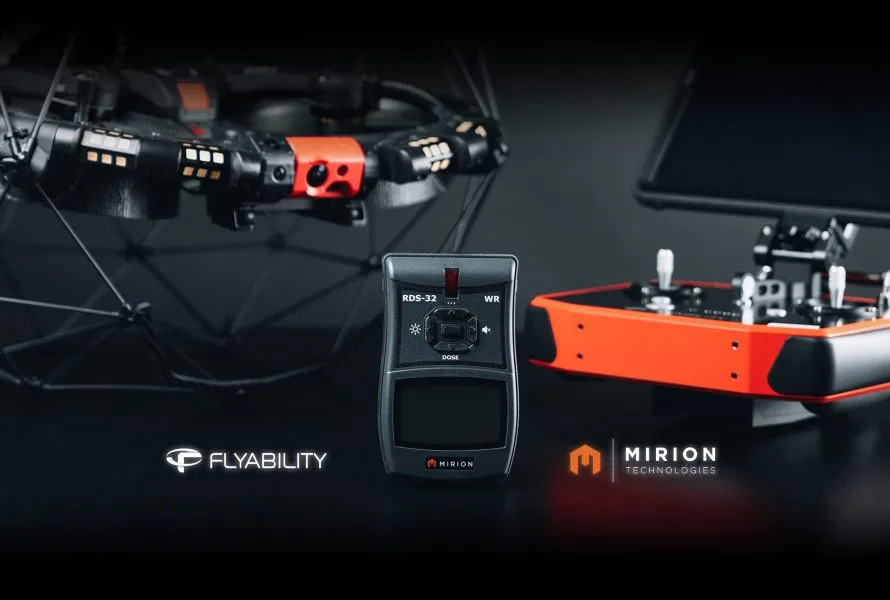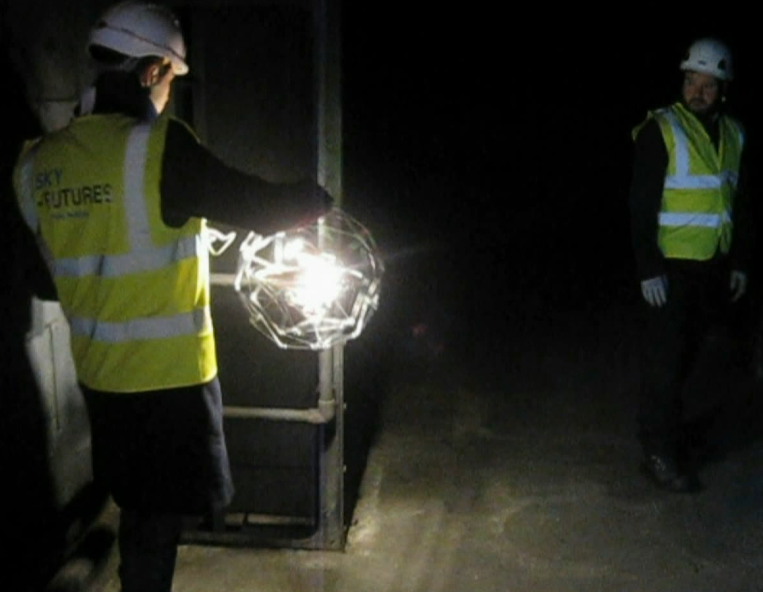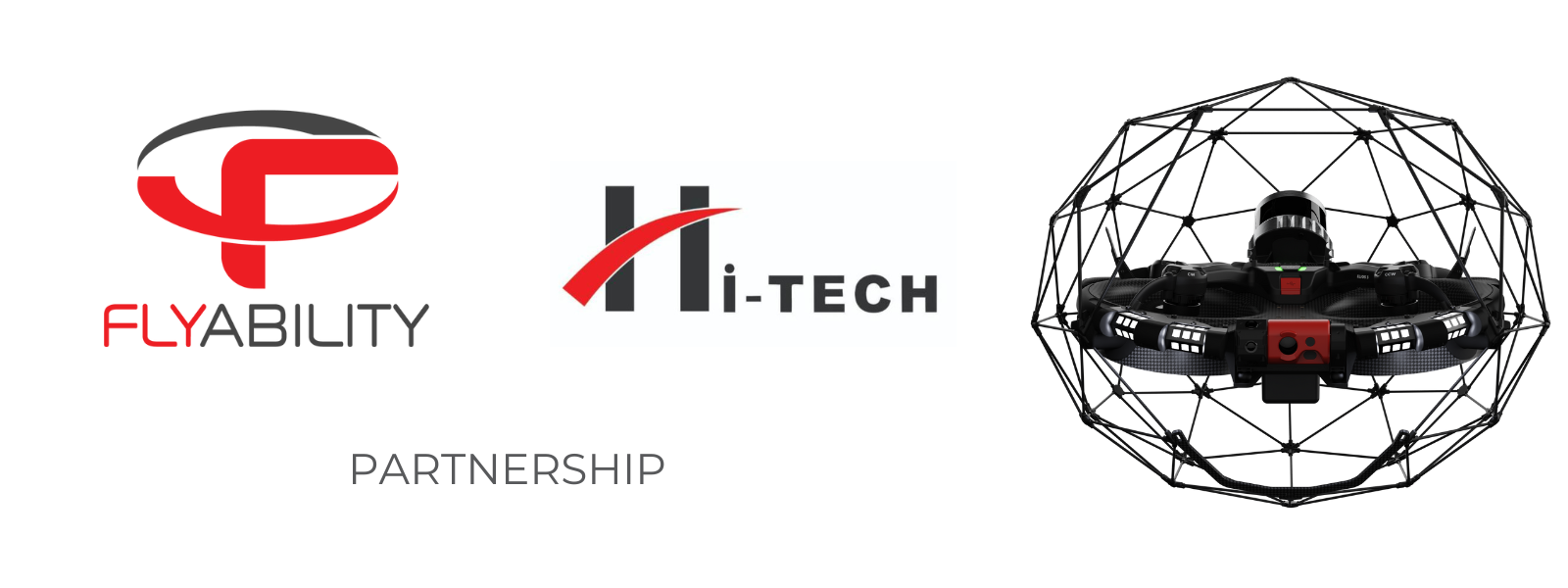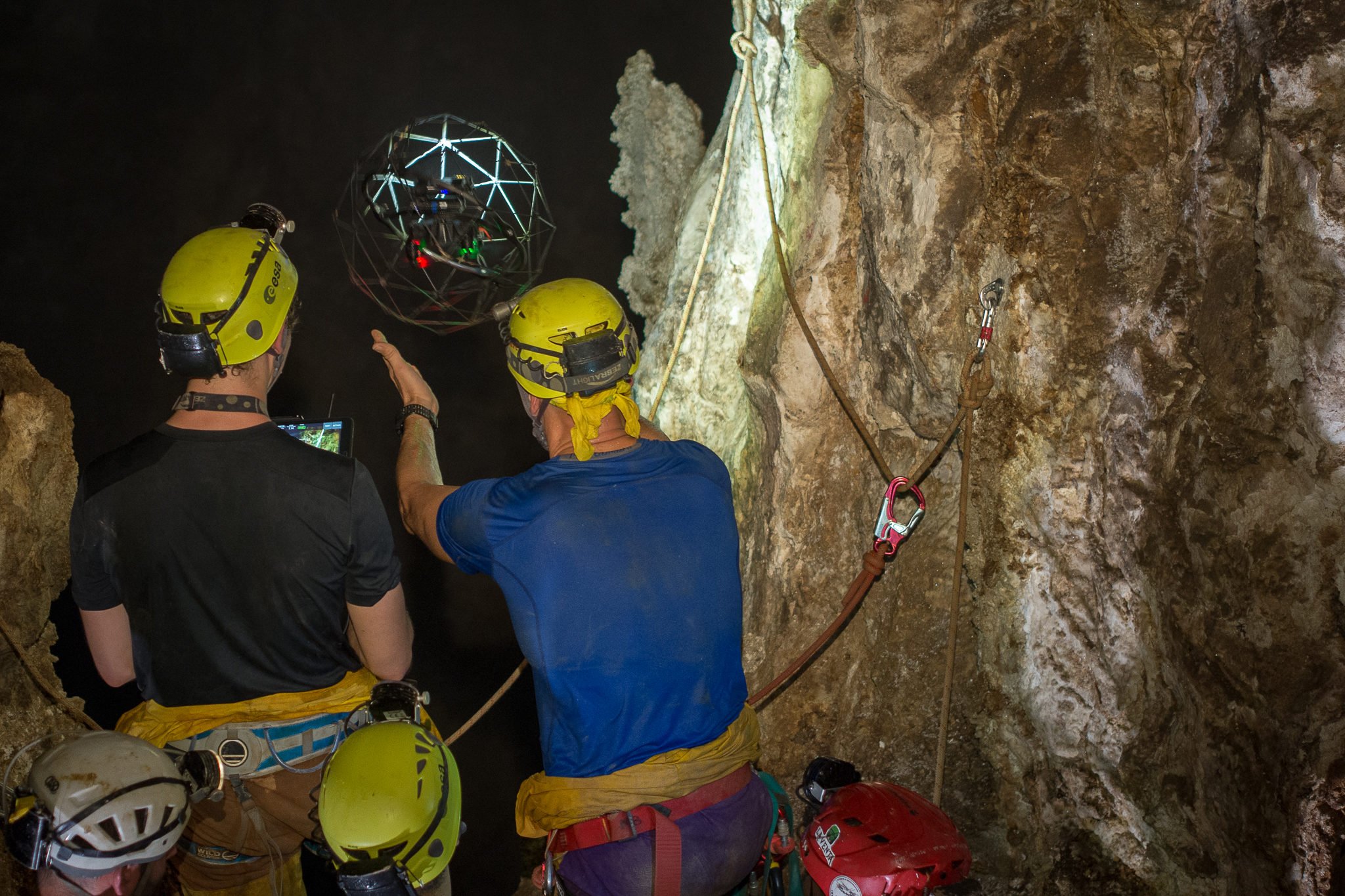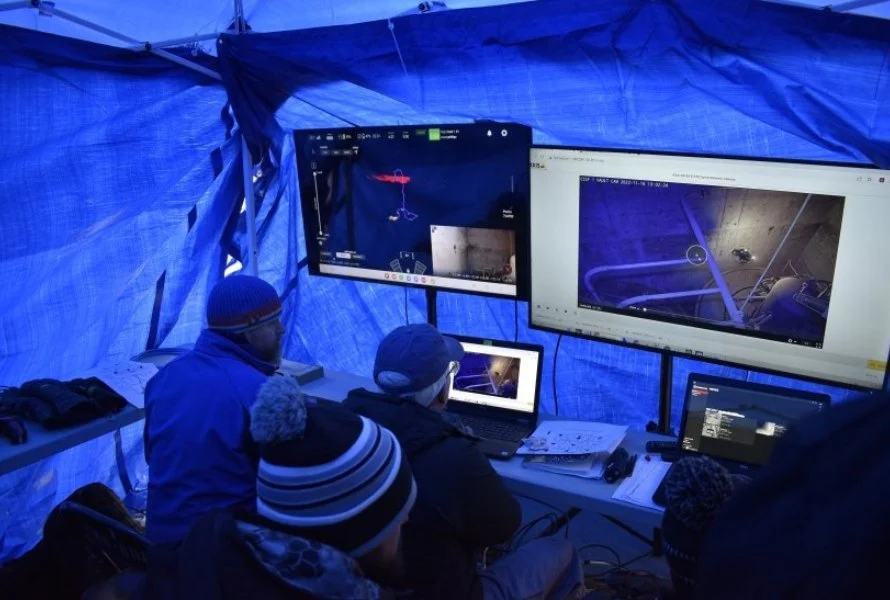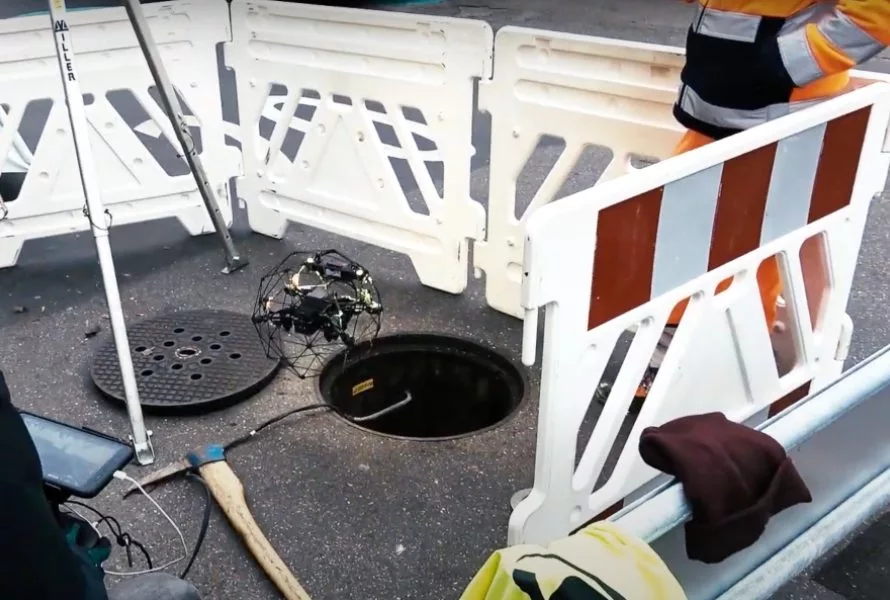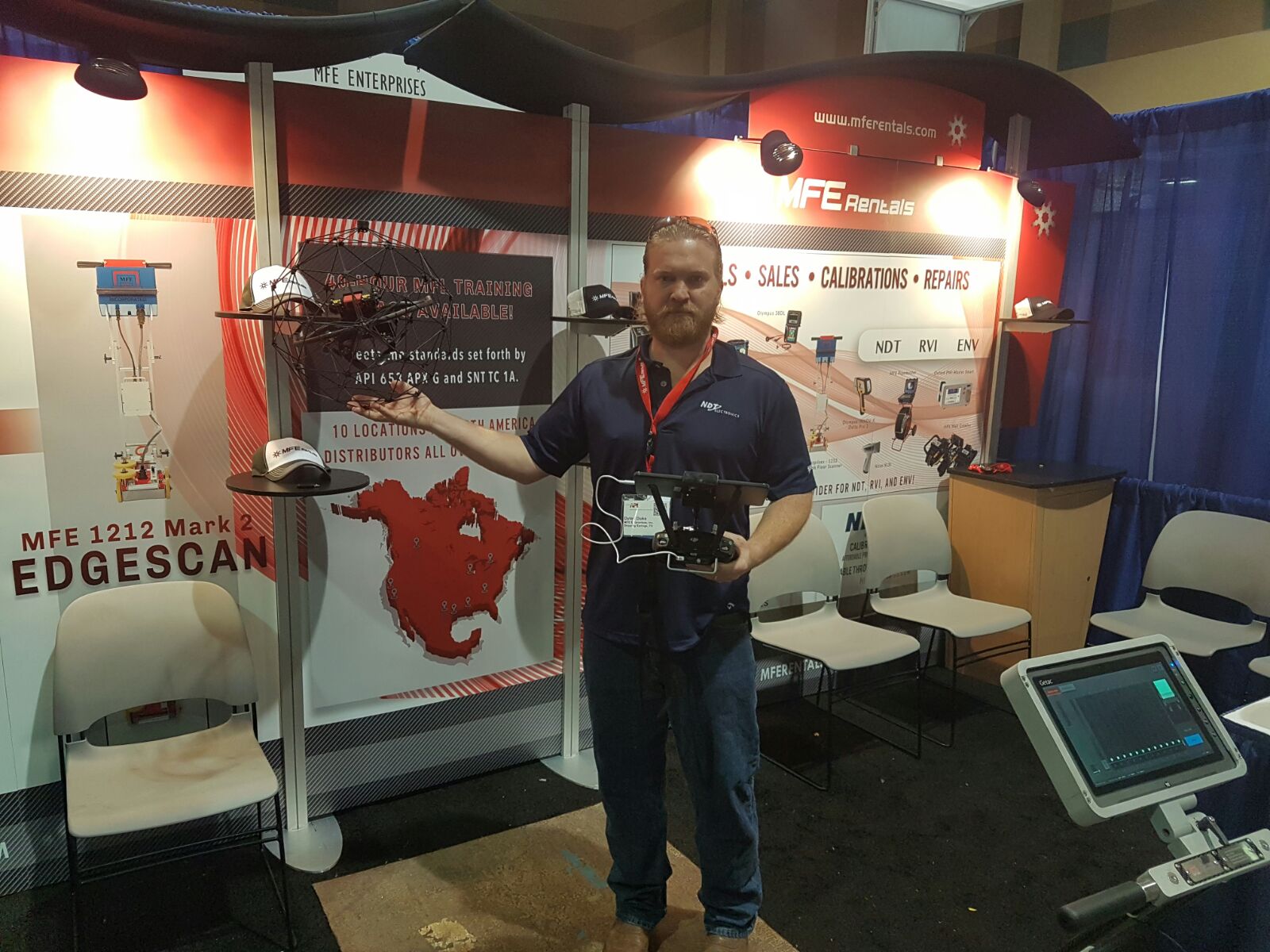What Is Scaffolding?
Scaffolding is a temporary structure that is typically made from metal poles and wood planks and used to support construction workers, inspectors, cleaners, and others who need to work at height.
[Note: This article is about scaffolding as it relates to industrial work. If you’re interested in learning about scaffolding as it relates to education, we recommend reading this article from Grand Canyon University.]
The use of scaffolding dates as far back as the stone age—in fact, there’s evidence that scaffolding was used over 17,000 years ago by those who made the famous paleolithic cave paintings at Lascaux.
Images of scaffolding have been found on ancient artifacts such as the Berlin Foundry Cup, a Greek drinking cup made in the 5th century BC.
Peoples as diverse as Nubians, Egyptians, and Chinese have documented the use of scaffolding for constructing tall buildings, using rudimentary scaffolds made of wood and tied at the top with ropes.
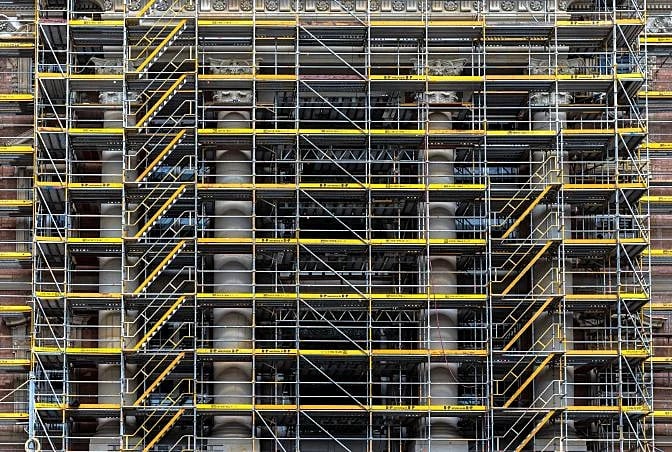
In the modern age, scaffolding has developed far beyond these early versions, and now comes in several different designs made from several different types of materials.
This article will cover how scaffolding is currently used, its types and parts, how to make it, navigating rental versus purchasing, and close out with a look at how new drone technology is helping workers across various industries significantly reduce their need for it.
[Scaffolding is commonly used by inspectors for non-destructive testing, also known as NDT. Learn more about NDT in this in-depth guide.]
Here is a table of contents to help you navigate all the information found in this article:
- What Is Scaffolding?
- Uses of Scaffolding
- Scaffolding Parts
- The Eight Types of Scaffolding
- How to Make Scaffolding
- Scaffolding Rental vs. Purchase
- How Drones Can Reduce the Need for Internal Scaffolding in Inspection Work
What Is Scaffolding?
A scaffold, also called scaffolding or staging, is a temporary structure that allows people to stand on a stable platform for work at height or in hard-to-reach places.
These temporary structures are often used in constructing, maintaining, or repairing buildings, bridges, and other man-made structures by supporting work crews and materials.
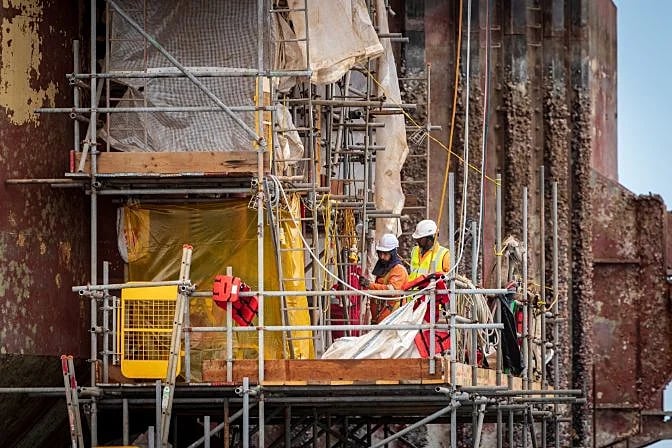
The Benefits of Scaffolding
There’s a reason scaffolding has been used for thousands of years—it works. To this day, scaffolding remains one of the most useful and efficient ways for people to work at height.
Here are the primary advantages to using scaffolds for work at height:
- Access. Scaffolding can allow unhindered, stable access to almost any area of a structure
- Balance. Scaffolds put workers on a firm footing, giving them the ability to balance themselves in different positions while working.
- Ease of construction. Scaffolding is relatively easy to assemble and disassemble, and can be put up and taken down fairly fast.
- Long-lasting. Most scaffolds can last for a very long time, whether they’re made from wood or from steel.
- Safety. Safety is one of the most significant advantages of scaffolding, since it gives workers a stable platform for their work. That being said, the ideal solution for work at heigh is to reduce or even remove the need for a person to be present—in the last section of this guide, we’ll cover how drones can help inspectors reduce their need to work at height.
- Serves as a bridge. A number of construction activities require workers to take long and winding routes to reach certain locations on the job site, which is an enormous waste of time. Bridging points in scaffolding can help solve this problem by reducing the distance that workers have to travel.
The Dangers of Working on Scaffolding
Any time a person has to work at height there is a risk associated with the work, and work on temporary structures like scaffolding is no different.
According to OSHA (the U.S. Occupational Safety and Health Administration):
- Scaffold-related accidents cause about 4,500 injuries and 60 deaths in the U.S. each year.
- Falls from scaffolding account for approximately 25% of all workplace fatalities.
- Almost 72% of those injured attributed their accident to the planking or support giving way, to slipping, or to being struck by a falling object.
- The most common safety violation on construction sites is inadequate fall protection training.
This data is just for the U.S. Extrapolating from these numbers to estimate global data, we can see that there are probably hundreds of deaths and tens of thousands of injuries related to work on scaffolding around the world every single year.
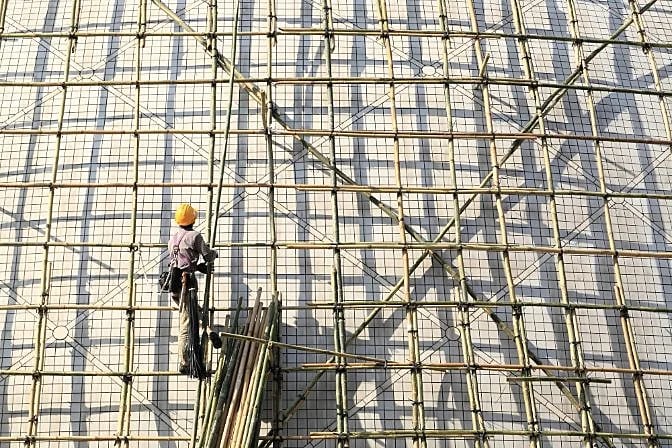
Given how common work on scaffolding is, the injury rate is not alarmingly high. But it is worth noting that scaffolding work carries inherent risks, and that, if you can avoid that work, you will improve safety for workers
Wondering what the most common dangers are associated with work on scaffolds?
Here are the most common:
- Defects. Scaffolding-related accidents are often caused by faulty scaffolding. Some examples of defects include compromised steel tubing is compromised or screws not lining up as they should.
- Falling objects. Falling objects like tools, construction materials, or debris are a common cause of injury for those working on staging. To avoid injuries associated with falling objects, a best practice is to provide a cover for each level of scaffolding.
- Weather. It can be extremely dangerous to work at height on a partially-constructed building when the weather is changing. Rain or snow can make the planking slippery, and temperature fluctuations can compromise attachment points and cause planks to loosen, crack, and fail.
- Ignoring safety standards. Numerous other factors can lead to serious and fatal accidents, including overloading scaffolding and placing scaffolding too close to hazardous energy sources.
- Inadequate training. Work on scaffolding and constructing scaffolding both call for specialized training. Scaffold builders and erectors must be trained in scaffolding construction and safety standards for the particular scaffolding they are erecting, and scaffold workers must be knowledgeable about the risks associated with scaffolding.
- Inadequate or weak planking. Scaffolding for all types of work must have sturdy planking for worker safety. Fall risks can result from weakened or inadequate scaffolding supports, posts, mast climbers, pump jacks, and other mechanisms.
- Inexperience, incompetence, and negligence. It’s extremely dangerous to work on a construction site with individuals who lack training or experience, or don’t take safety risks seriously. The negligence of coworkers can be especially dangerous when scaffolding is involved.
- Insufficient supply of safety equipment. It is still necessary to provide workers with access to appropriate safety equipment even when scaffolds are designed, manufactured, and constructed properly.
- Poor construction. Accidents on construction sites are often caused by improper scaffolding construction, which includes failing to attach all attachment points properly, failure to install bracing, or failure to install guardrails.
- Poor maintenance. To remain structurally sound scaffolding needs to be properly maintained. Old materials can wear out with time, and slippery surfaces and other safety hazards can also occur as a result of inadequate maintenance.
Uses of Scaffolding
Scaffolding is used for a variety of activities these days. Here are some of the most common uses of scaffolding:
Cleaning
Workers commonly can stand on scaffolding to clean windows and other parts of skyrise buildings.
Construction
Scaffolding can be crucial for construction, since it allows workers to stand at height on a stable surface. This is especially true for skyscrapers and other high rise structures, but its use is also common for construction work done closer to the ground.
Industrial inspections
Inspections are one of the top uses of scaffolding, since scaffolding allows inspectors to reach areas they couldn’t otherwise access in order to perform visual inspections or other kinds of NDT testing.
Inspectors commonly use internal scaffolding or other temporary structures for internal inspections, like those performed inside huge industrial boilers or pressure vessels, as well as for external inspections. Regardless of the specific inspection, the use of the scaffolding is the same—it allows inspectors to stand at height and conduct various types of testing in order to satisfy inspection requirements.
Maintenance
Inspections are typically the first step in a maintenance process, since they uncover areas that may require maintenance. After inspectors find these areas, maintenance workers will address those defects by standing on scaffolding to perform their work.
Other uses
Various types of scaffolding are also used in:
- Art installations
- Concert stages
- Exhibition stands
- Grandstand seating
- Observation towers
- Shoring
- Ski ramps
Scaffolding Parts
Here are all the parts used to make scaffolds:
- Standards.This is a framework that consists of vertical members supported on the ground, on drums, or embedded into the ground.
- Ledgers. Tubes with a case wedge fixing device on their end that are positioned horizontally between two standards, defining the length of the scaffold bay.
- Braces. Braces are fixed diagonally to the standards.
- Putlogs. A putlog connects the wall being worked on and the ledger. A putlog hole is made in the side of a building to receive a putlog.
- Transoms. A transom is a type of ledger putlog that is supported by both ledgers.
- Bridle. Bridles support one end of the putlog and are used to bridge an opening in a wall.
- Boarding. During the working process, boarders serve as horizontal platforms for supporting workmen and materials.
- Guard rail. A rail set up at the same level as a ledger.
- Toeboard. A parallel set of boards, supported on putlogs, which provides protection at the working platform level.
- Ladder scaffolding. Scaffolding ladders allow workers to ascend and descend the constructed scaffold easily.
- Scaffolding wheels. Wheels at the bottom of the scaffold that allow easy movement of the scaffold from one place to another.
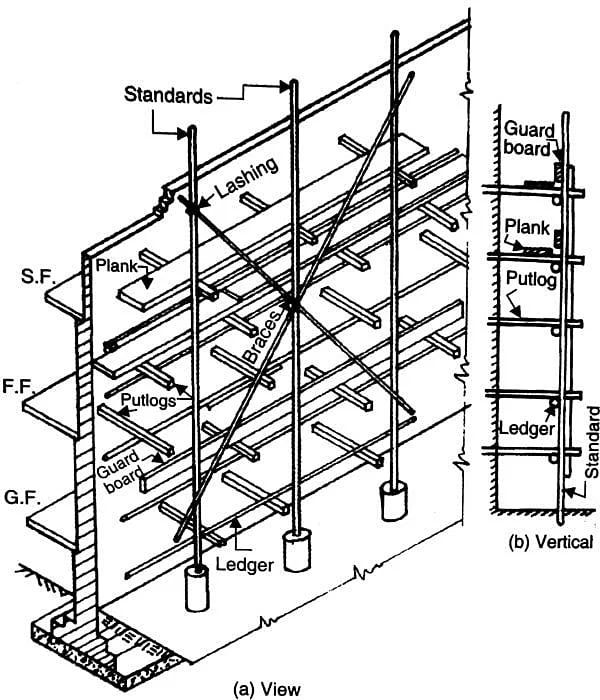
Credit: CementConcrete.org
The Eight Types of Scaffolding
Here are the eight types of scaffolding most commonly used throughout the world.
1. Aerial lifts
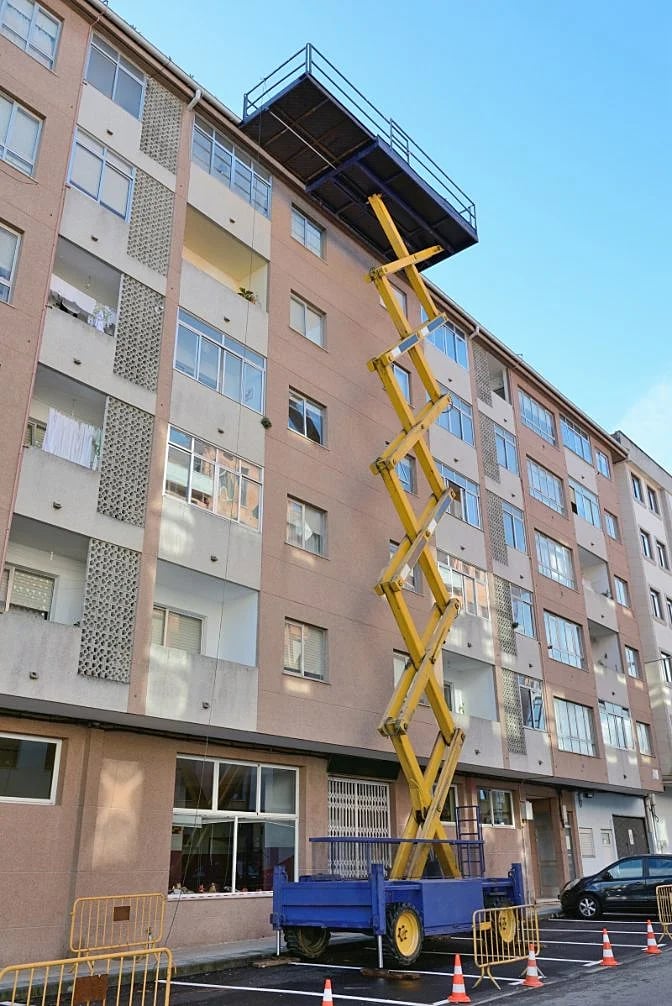
Aerial lifts are commonly used for construction projects that require workers to access a variety of different levels in a single day or work cycle.
An aerial lift can be used not only to move people, but also to provide an easier and safer way to lift large amounts of materials up or down to those doing the work.
2. Cantilever scaffolding
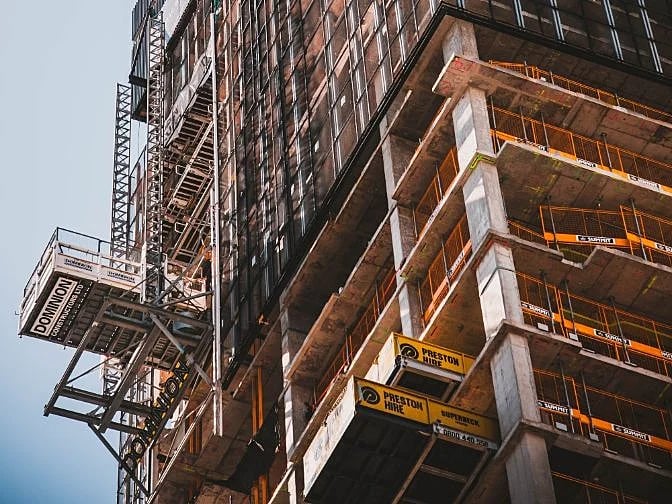
Cantilever scaffolding (also called needle scaffolding) is made to come out from a building at an angle using a separate scaffold.
This type of scaffold can get rid of the need for unsightly frames or poles to be used on the fronts of buildings, and is often constructed near balconies to give workers an easy way to access it.
3. Double scaffolding
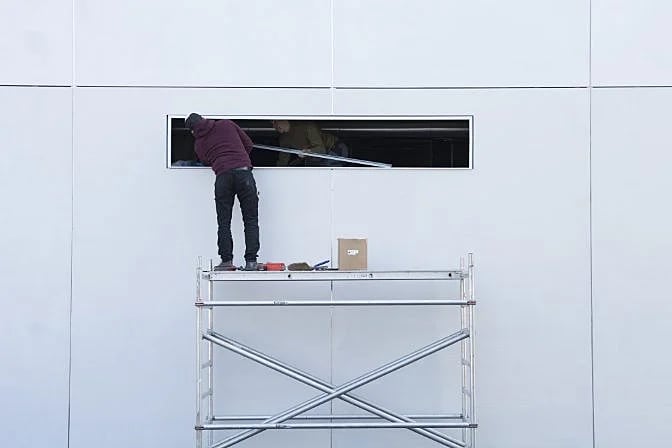
Double scaffolding is a type of readymade scaffolding that is commonly used for stonemasonry. The stone surface makes it hard to install scaffolding directly into the wall, so double scaffolding gives workers a way to work at height without having to create a structure that is attached to the stones.
Double scaffolding uses a two-tier support to ensure stability, with additional support provided by cross braces and rakers.
4. Patented scaffolding
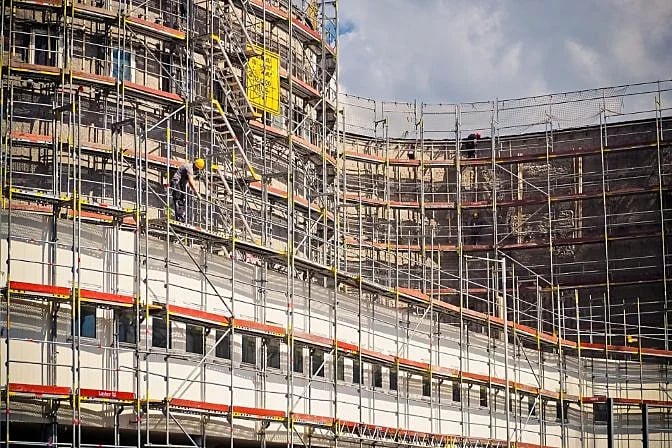
Patented scaffolds are readymade and have special couplings and frames attached, coming with brackets that support the working platform. In some types, the brackets can be adjusted to different levels to support work at various heights.
5. Single scaffolding
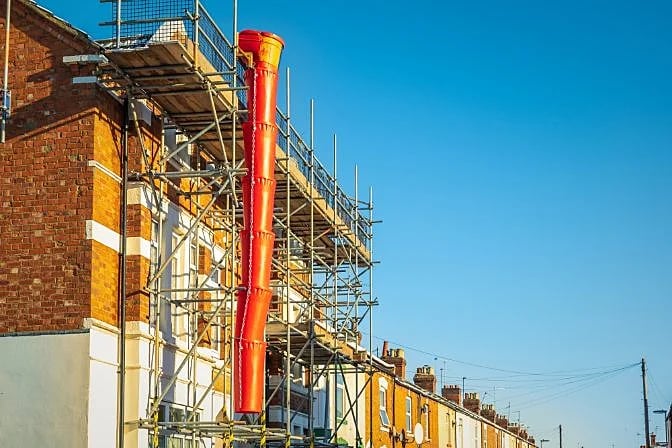
Single scaffolding is one of the oldest construction methods, and it’s commonly used for work on brick masonry. Though relatively simple, this approach creates a sturdy and reliable structure for work at height.
6. Suspended scaffolds
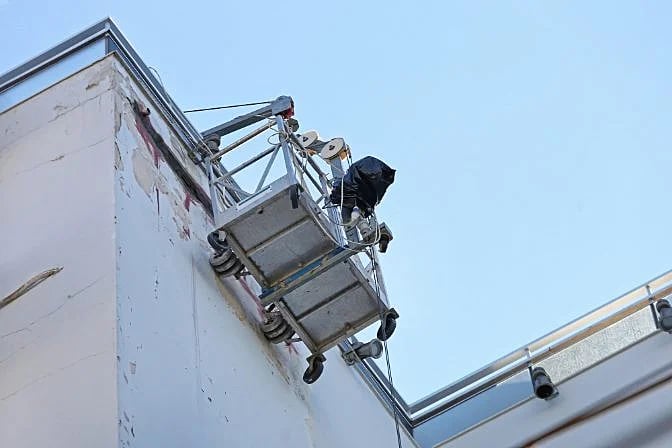
Suspended scaffolds are another type of readymade scaffolding. It's lightweight and commonly used for repair work, including painting.
The name comes from the fact that they are suspended from the roof of a building by wire, ropes, or chains. The platform supported by suspended scaffolding can be raised or lowered as needed.
7. Supported scaffolds
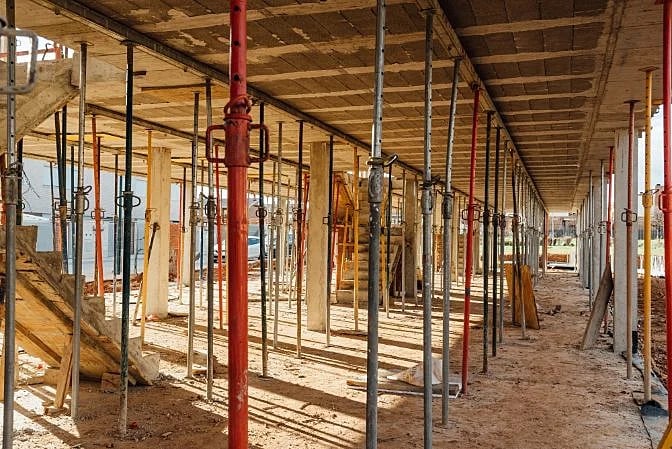
Supported scaffolds are most commonly used in construction, and they’re one of the go-to options when it comes to building temporary structures for work at height. This kind of scaffolding is simple, cost-effective, and built from the base upwards.
A supported scaffold can have many forms, each of which serves a specific purpose. If the scaffolding is long or needs to support a lot of weight, workers may need to add additional support to its base.
8. Trestle scaffolding
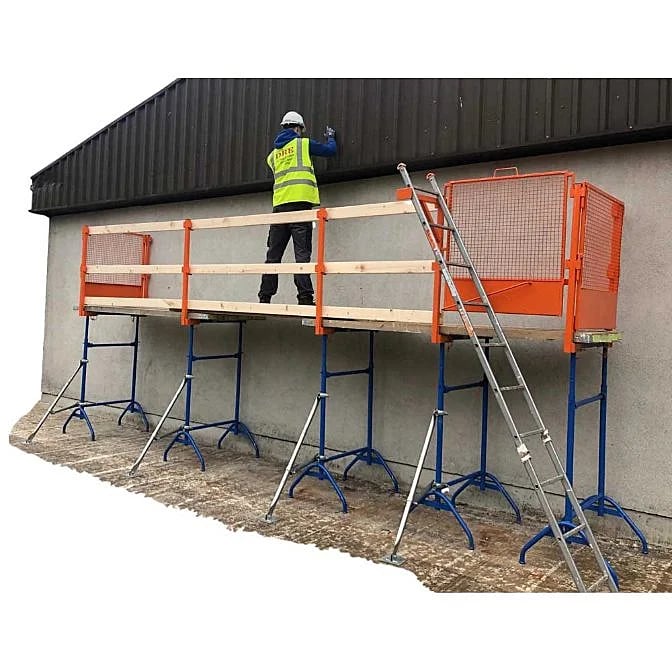
Credit: Dermot Redmond Engineering
In trestle scaffolding, a tripod or portable scaffold board provides a platform for laborers to work from.
Trestle scaffolding is usually used in small spaces for painting or minor repairs. There are no standards or putlogs, only working platforms supported by movable ladders. The platform can be moved easily from one place to another.
Scaffolding Materials
Scaffolding can be made out of a variety of materials—here are three of the most common:
- Aluminum scaffolding. Aluminum is widely used for scaffolding due to being lightweight, durable, and highly resistant to corrosion.
- Bamboo scaffolding. Bamboo presents a great alternative to steel since it is quite strong, flexible, lightweight, easy to work with, and abundant in certain parts of the world. In Hong Kong, for instance, bamboo is the most common material used for scaffolding, and is often upcycled from other uses to avoid unnecessary waste.
- Steel scaffolding. Steel scaffolding is one of the most popular materials for scaffolding. Although it is more expensive than bamboo or aluminum, it is quite strong and durable, and presents an ideal option for work in dense urban areas.
How to Make Scaffolding
Here is an overview of the steps required to craft scaffolding:
- Secure the foundation. Scaffolding should be built level and on secure ground. To ensure stability, attach the scaffolding to base plates or mud sills—you may need to dig down to make the dirt level if you are on an uneven surface.
- Level it. Make sure that the scaffolding is leveled using adjusting screws. You may need leg extensions if the surface slopes dramatically.
- Consider casters. The scaffolding setup should include casters if you plan on moving it from spot to spot. Make sure the casters are locked when you put it in place.
- Ensure proper assembly. The scaffolding ends must be properly assembled. First lift one end section, then attach the top cross brace. To attach the upper cross brace of the second end piece, you should lift the far end of this brace to support the end piece. Finally, connect the cross braces to the bottom of the opposite end frame by securing the ends.
- Position planks. Move the planks over the scaffold bar and into position, fastening them in place with the provided hardware.
- Determine access. Make sure you consider access when setting up your scaffold. If ladders are used for access, ensure they are designed for the specific scaffold you’re using and won’t tip over or present other safety hazards.
- Attach guardrails. All scaffolds should be fitted with guardrails due to the height of the equipment and the risk of falling. You should also consider fall protection measures, such as tie-offs.
- Inspect it. Strictly inspect the scaffolding to ensure it is safe to use. Make sure all scaffolding pieces are secure by thoroughly inspecting the setup. Always recheck the scaffold system after leaving and returning to the site to ensure it is still safe.
Scaffolding Rental vs. Purchase
There are many factors to consider when trying to decide whether to rent scaffolding or purchase scaffolding. In general, most big companies that use scaffolding choose to rent instead of deal with the logistics and cost that come with buying and storing their own.
However, there are some scenarios where buying your own could make sense—here are some things to keep in mind when trying to decide whether to rent or buy scaffolding.
When You Should Rent Scaffolding
You may want to rent scaffolding if:
- You don’t expect to use it very often.
- You only need it periodically—for inspectors conducting routine inspections, rental is almost always the best way to go, since these inspections typically only happen once every few years.
- Your timeframe is three months or less.
- Your project requires work at heights of 20 feet or more.
- You don’t have experience building/taking down scaffolding (rentals can often be bundled with construction/dismantling fees).
- You’re working on an unusual surface, like something that is curved or otherwise awkwardly shaped, and need professional help to construct your scaffolding.
When You Should Buy Scaffolding
You may want to buy scaffolding if:
- You have regular, long-term need for it.
- Your project will take longer than three months.
- Your project is fairly simple with just straight-line elevations.
- You only plan to work at heights of 20 feet or less.
- You already have a safety program in place and have the necessary personnel to erect the scaffolding and dismantle it or you know how to erect, dismantle, and build it.
How Drones Can Reduce the Need for Internal Scaffolding in Inspection Work
or inspections at height, there are typically three options for inspectors:
- Scaffolding
- Rope access
- Drones
The first two options require inspectors to physically work at height, either by using ropes or standing on scaffolding. For that reason, both of these approaches present potential dangers to the inspector for the collection of inspection data.
But the third option—drones—presents a way for inspectors to collect the data they need remotely, without having to put themselves in danger.

Drones like Flyability's Elios 3 (shown above) can fly up to locations at height to collect high quality visual data, allowing inspectors to reduce or even fully eliminate the need to work on scaffolding or on ropes.
Here are some of the primary reasons inspectors are turning to drones as a replacement for the need to work on internal scaffolding:
- Safety. Because drones can collect visual data remotely, inspectors don’t have to place themselves in danger by working at height on scaffolding to collect that data.
- Savings. The cost of putting up and taking down temporary structures like scaffolding for inspections can be incredibly high, sometimes costing tens of thousands or even hundreds of thousands of dollars. The need for scaffolding for inspection work can be significantly reduced using drones, which represents significant cost savings for companies.
- Reduced downtimes. Because scaffolding takes so long to erect and take down it can significantly extend the downtime for an asset, leading to further expenses for a company. By reducing or even removing the need for scaffolding for inspections, drones can significantly increase savings for companies.
- Speed. Drones can collect visual data more quickly than an inspector conducting a manual inspection, further improving the efficiency of the inspection process.
We are hosting demonstrations throughout the world to showcase our new indoor inspection drone.
Sign up to see the Elios 3 live in a location near you.



